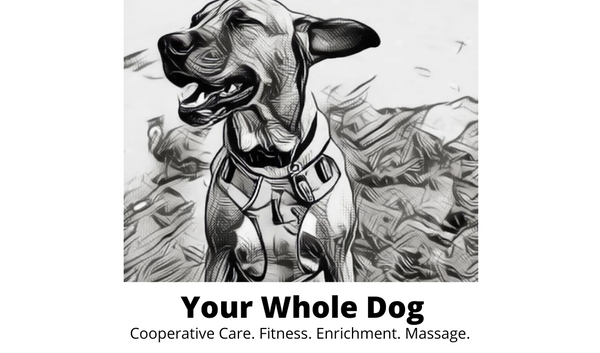
Your Whole Dog: a Story of Many Parts - Part Three
Who (or what) is Your Whole Dog? And, what do they do? Why do they do whatever it is they do?
I covered cooperative care in Part One and canine fitness and conditioning in Part Two
This is Part Three, and it's a multi-dog story all about massage.
When Lizzie, the overweight - morbidly obese, to be more accurate - Labrador, came to live with us, massage was part of her Fat Dog Slim restoration program. Up until then I had no idea canine massage was a thing. I learnt a lot thanks to Lizzie.

Lizzie. A very fat Labrador
When Lizzie was scheduled for a massage (or a trip to hydro) I used to get a lot of comments about her being pampered, having a spa day, or even bring spoiled. I didn't see it like that, we were just trying to help her feel better and live her best life. I'm big on quality of life and proactive, preventative, multi-disciplinary, multi-modal health care.
Side bar: On reflection, I think a lot of it has to do with society's current way of living and our collective tendency to not look after ourselves; our reluctance to realise the benefits of a wholistic and proactive way of living. We see taking care of ourselves as a luxury, rather than the necessity it is.
Lizzie had stiff joints and what I now recognise as a diabolical movement pattern! Massage helped reduce pain and inflammation; it eased muscle tension; and it improved range of motion. It's hard to know who enjoyed the process more - her or her massage therapist! When Lizzie was able to move in a more balanced manner, she could exercise more safely, which meant she could move more freely, which meant she could exercise more. All that movement helped her joint function, her muscle development, her weight loss, and her joie de vivre. Win win.

Lizzie became so mobile she even dabbled in some (fun, very low-level and safe and Lizzie appropriate) agility.
Around the same time I was also learning that Wolly was suspicious of handling. And I was introduced to TTouch. Lots going on! Fast forward a year or so and I had discovered that Wolly would still reject 'handling' but seemed to quite like TTouch and massage. Perhaps this was progress. As Wolly and I embarked on the wild ride that is cooperative care I could disguise handling and body exams with massage and TTouch. He was learning that hands on didn't have to be an awful experience to be distrusted. That was most certainly a win.

Wolly now regularly gets taped to help his twitchy ol' back.
Then along came Tigg, and with her came hip dysplasia. We started on an exercise program, and alongside that she went to hydrotherapy and she saw a Veterinary Physiotherapist. During my hip dysplasia education, I learnt how the disease goes beyond the hip joints; it affects the whole body, causing muscle tension and soreness as the dog compensates for the laxity in the joint. What's good for tight, sore muscles? Massage!

Tigg, the ultimate fidget, has figured out that staying still is just about worthwhile!
And so, it began. I started by taking courses for owners and learning how to massage my own dogs. After all, that's all I wanted and needed to be able to do.
Fast forward to Your Whole Dog being born, and seeing client dogs for training consults. Sometimes I'd notice that they moved a bit 'funny' and felt a bit 'off' (both valid technical terms!). Given the correlation between health and behaviour, and the synergy between fitness and bodywork, well, a massage certification course seemed like a logical next step.

A few of my case study helpers!
And there you have it, a condensed version of how I ended up becoming a canine massage therapist and adding massage to Your Whole Dog's services.
Fun fact: I'm also trained as a human massage therapist, thanks to former life endeavours unrelated to dog stuff! That happened somewhere between Lizzie leaving us and Tigg joining us.
If you're wondering whether massage would benefit your dogs, send me an email. I get a lot of queries asking if massage would help a range of problems, and the answer is almost always yes; massage is beneficial for so many things. But it's important to understand that it's not necessarily the only solution. Getting to the root of the problem and having massage as a part of a comprehensive plan will usually yield the best result. And that’s something I can help you navigate. Maybe it’s as simple as some environmental adaptations, such a runner in the hall or a ramp off the deck. Sometimes it's more complicated and we need to collaborate with other professionals.
It doesn't matter if your dog is squirmy; my massage consults focus on ensuring your dog is comfortable, and able to get up and move around if they need a break. Not only are you hiring a canine massage therapist, you're hiring one that understands dog behaviour, can read dog body language and uses low-stress and fear free handling methods. If massage sounds like it's something that would benefit your dogs you can be assured that I use these skills everyday with my own dogs.

